Environmental Scan for Coles Supermarkets Australia Pty Ltd
VerifiedAdded on 2023/06/04
|14
|3329
|85
AI Summary
This report evaluates the external environmental impact on business operations, market share, the brand positioning, and sales revenues for Coles Supermarket. It also applies the appropriate frameworks to resolve the complex issues and challenges faced by the firm and specific industry factors in the context of the firms’ decisions.
Contribute Materials
Your contribution can guide someone’s learning journey. Share your
documents today.
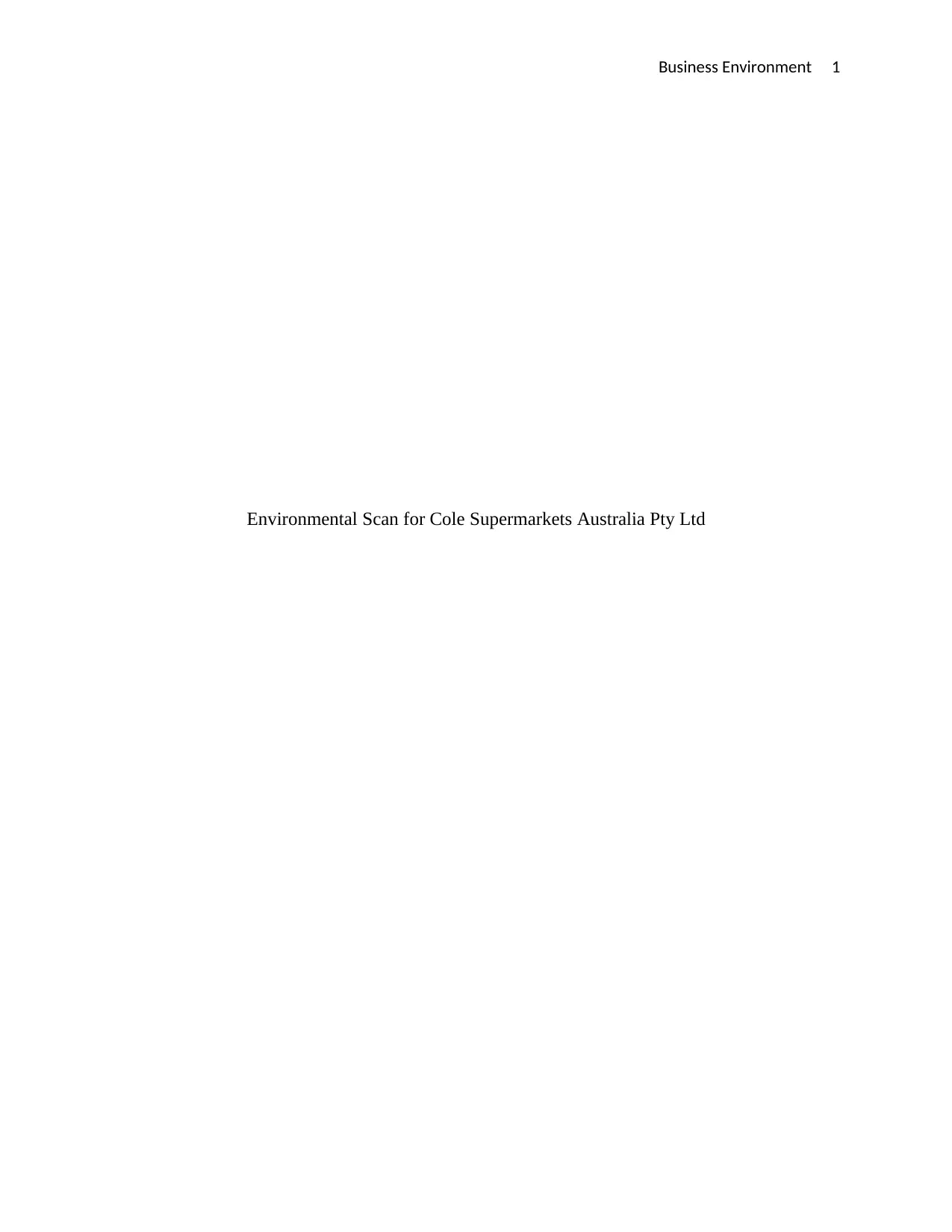
Business Environment 1
Environmental Scan for Cole Supermarkets Australia Pty Ltd
Environmental Scan for Cole Supermarkets Australia Pty Ltd
Secure Best Marks with AI Grader
Need help grading? Try our AI Grader for instant feedback on your assignments.
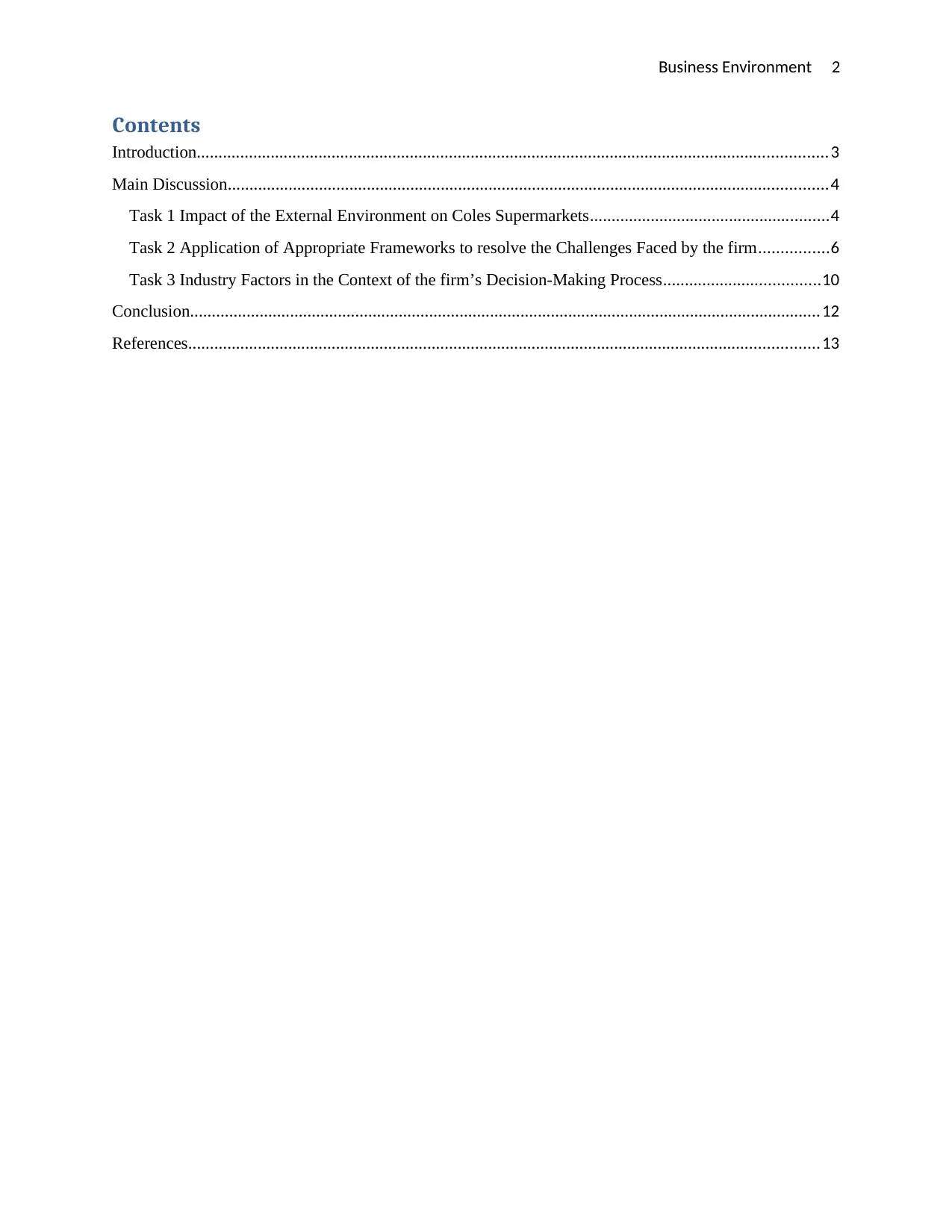
Business Environment 2
Contents
Introduction.................................................................................................................................................3
Main Discussion..........................................................................................................................................4
Task 1 Impact of the External Environment on Coles Supermarkets.......................................................4
Task 2 Application of Appropriate Frameworks to resolve the Challenges Faced by the firm................6
Task 3 Industry Factors in the Context of the firm’s Decision-Making Process....................................10
Conclusion.................................................................................................................................................12
References.................................................................................................................................................13
Contents
Introduction.................................................................................................................................................3
Main Discussion..........................................................................................................................................4
Task 1 Impact of the External Environment on Coles Supermarkets.......................................................4
Task 2 Application of Appropriate Frameworks to resolve the Challenges Faced by the firm................6
Task 3 Industry Factors in the Context of the firm’s Decision-Making Process....................................10
Conclusion.................................................................................................................................................12
References.................................................................................................................................................13
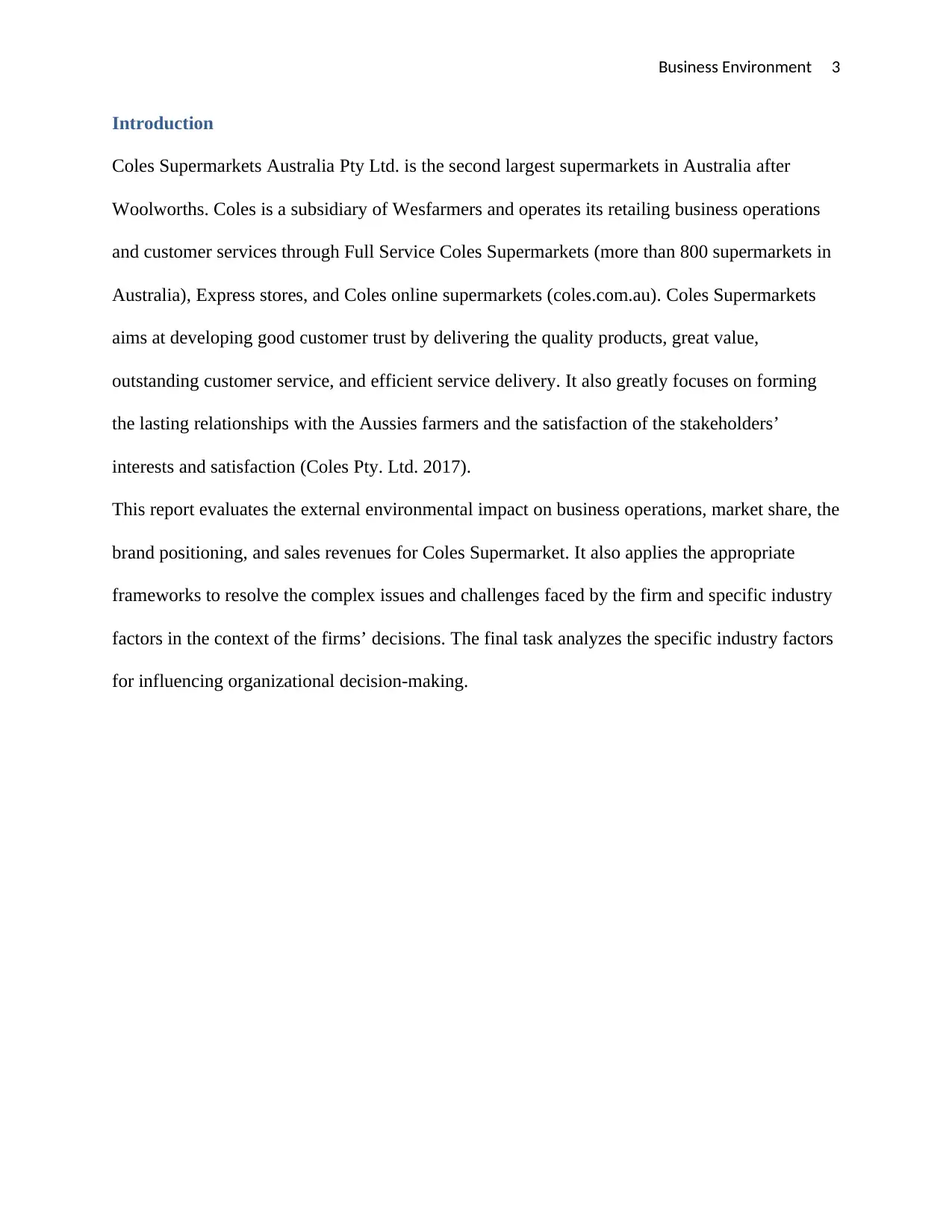
Business Environment 3
Introduction
Coles Supermarkets Australia Pty Ltd. is the second largest supermarkets in Australia after
Woolworths. Coles is a subsidiary of Wesfarmers and operates its retailing business operations
and customer services through Full Service Coles Supermarkets (more than 800 supermarkets in
Australia), Express stores, and Coles online supermarkets (coles.com.au). Coles Supermarkets
aims at developing good customer trust by delivering the quality products, great value,
outstanding customer service, and efficient service delivery. It also greatly focuses on forming
the lasting relationships with the Aussies farmers and the satisfaction of the stakeholders’
interests and satisfaction (Coles Pty. Ltd. 2017).
This report evaluates the external environmental impact on business operations, market share, the
brand positioning, and sales revenues for Coles Supermarket. It also applies the appropriate
frameworks to resolve the complex issues and challenges faced by the firm and specific industry
factors in the context of the firms’ decisions. The final task analyzes the specific industry factors
for influencing organizational decision-making.
Introduction
Coles Supermarkets Australia Pty Ltd. is the second largest supermarkets in Australia after
Woolworths. Coles is a subsidiary of Wesfarmers and operates its retailing business operations
and customer services through Full Service Coles Supermarkets (more than 800 supermarkets in
Australia), Express stores, and Coles online supermarkets (coles.com.au). Coles Supermarkets
aims at developing good customer trust by delivering the quality products, great value,
outstanding customer service, and efficient service delivery. It also greatly focuses on forming
the lasting relationships with the Aussies farmers and the satisfaction of the stakeholders’
interests and satisfaction (Coles Pty. Ltd. 2017).
This report evaluates the external environmental impact on business operations, market share, the
brand positioning, and sales revenues for Coles Supermarket. It also applies the appropriate
frameworks to resolve the complex issues and challenges faced by the firm and specific industry
factors in the context of the firms’ decisions. The final task analyzes the specific industry factors
for influencing organizational decision-making.
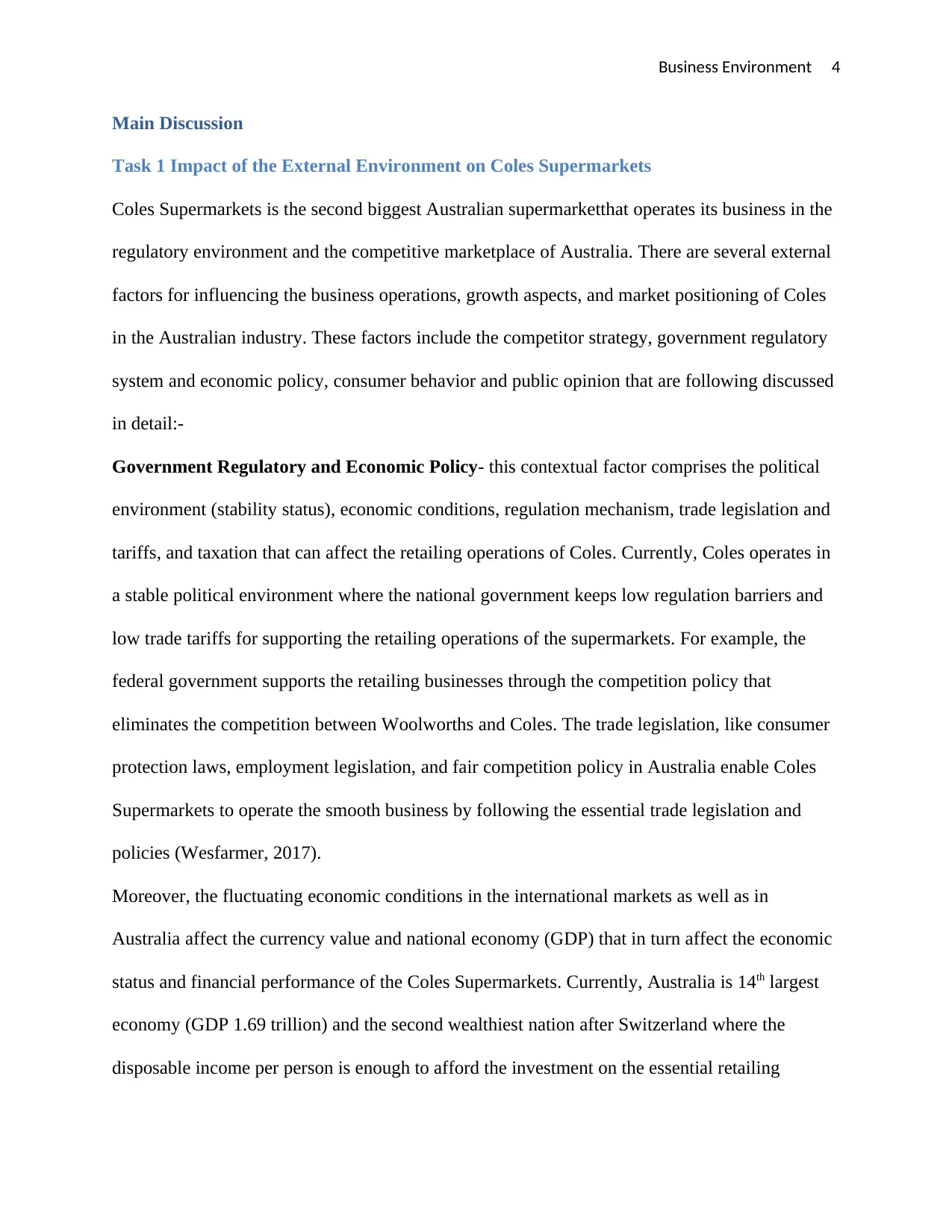
Business Environment 4
Main Discussion
Task 1 Impact of the External Environment on Coles Supermarkets
Coles Supermarkets is the second biggest Australian supermarketthat operates its business in the
regulatory environment and the competitive marketplace of Australia. There are several external
factors for influencing the business operations, growth aspects, and market positioning of Coles
in the Australian industry. These factors include the competitor strategy, government regulatory
system and economic policy, consumer behavior and public opinion that are following discussed
in detail:-
Government Regulatory and Economic Policy- this contextual factor comprises the political
environment (stability status), economic conditions, regulation mechanism, trade legislation and
tariffs, and taxation that can affect the retailing operations of Coles. Currently, Coles operates in
a stable political environment where the national government keeps low regulation barriers and
low trade tariffs for supporting the retailing operations of the supermarkets. For example, the
federal government supports the retailing businesses through the competition policy that
eliminates the competition between Woolworths and Coles. The trade legislation, like consumer
protection laws, employment legislation, and fair competition policy in Australia enable Coles
Supermarkets to operate the smooth business by following the essential trade legislation and
policies (Wesfarmer, 2017).
Moreover, the fluctuating economic conditions in the international markets as well as in
Australia affect the currency value and national economy (GDP) that in turn affect the economic
status and financial performance of the Coles Supermarkets. Currently, Australia is 14th largest
economy (GDP 1.69 trillion) and the second wealthiest nation after Switzerland where the
disposable income per person is enough to afford the investment on the essential retailing
Main Discussion
Task 1 Impact of the External Environment on Coles Supermarkets
Coles Supermarkets is the second biggest Australian supermarketthat operates its business in the
regulatory environment and the competitive marketplace of Australia. There are several external
factors for influencing the business operations, growth aspects, and market positioning of Coles
in the Australian industry. These factors include the competitor strategy, government regulatory
system and economic policy, consumer behavior and public opinion that are following discussed
in detail:-
Government Regulatory and Economic Policy- this contextual factor comprises the political
environment (stability status), economic conditions, regulation mechanism, trade legislation and
tariffs, and taxation that can affect the retailing operations of Coles. Currently, Coles operates in
a stable political environment where the national government keeps low regulation barriers and
low trade tariffs for supporting the retailing operations of the supermarkets. For example, the
federal government supports the retailing businesses through the competition policy that
eliminates the competition between Woolworths and Coles. The trade legislation, like consumer
protection laws, employment legislation, and fair competition policy in Australia enable Coles
Supermarkets to operate the smooth business by following the essential trade legislation and
policies (Wesfarmer, 2017).
Moreover, the fluctuating economic conditions in the international markets as well as in
Australia affect the currency value and national economy (GDP) that in turn affect the economic
status and financial performance of the Coles Supermarkets. Currently, Australia is 14th largest
economy (GDP 1.69 trillion) and the second wealthiest nation after Switzerland where the
disposable income per person is enough to afford the investment on the essential retailing
Secure Best Marks with AI Grader
Need help grading? Try our AI Grader for instant feedback on your assignments.
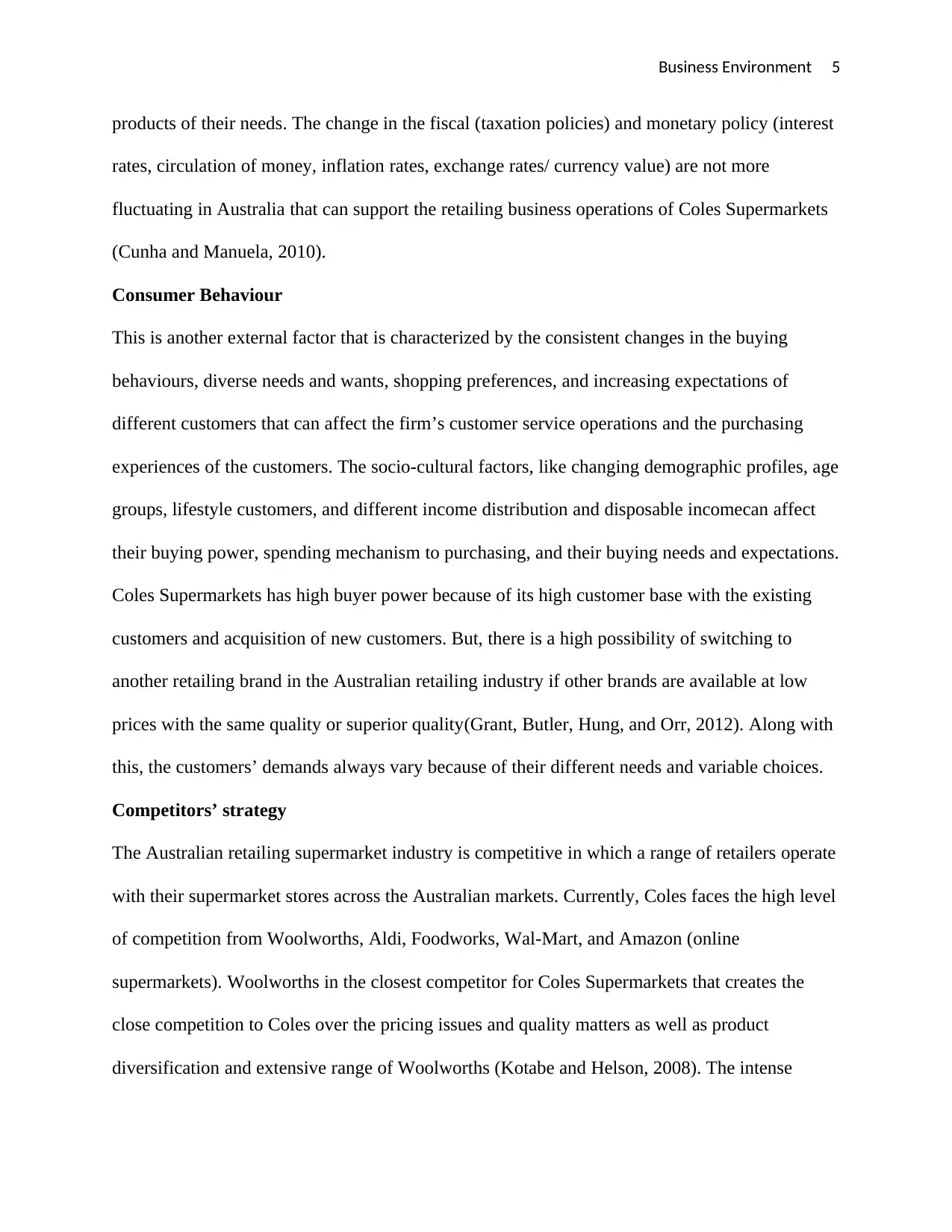
Business Environment 5
products of their needs. The change in the fiscal (taxation policies) and monetary policy (interest
rates, circulation of money, inflation rates, exchange rates/ currency value) are not more
fluctuating in Australia that can support the retailing business operations of Coles Supermarkets
(Cunha and Manuela, 2010).
Consumer Behaviour
This is another external factor that is characterized by the consistent changes in the buying
behaviours, diverse needs and wants, shopping preferences, and increasing expectations of
different customers that can affect the firm’s customer service operations and the purchasing
experiences of the customers. The socio-cultural factors, like changing demographic profiles, age
groups, lifestyle customers, and different income distribution and disposable incomecan affect
their buying power, spending mechanism to purchasing, and their buying needs and expectations.
Coles Supermarkets has high buyer power because of its high customer base with the existing
customers and acquisition of new customers. But, there is a high possibility of switching to
another retailing brand in the Australian retailing industry if other brands are available at low
prices with the same quality or superior quality(Grant, Butler, Hung, and Orr, 2012). Along with
this, the customers’ demands always vary because of their different needs and variable choices.
Competitors’ strategy
The Australian retailing supermarket industry is competitive in which a range of retailers operate
with their supermarket stores across the Australian markets. Currently, Coles faces the high level
of competition from Woolworths, Aldi, Foodworks, Wal-Mart, and Amazon (online
supermarkets). Woolworths in the closest competitor for Coles Supermarkets that creates the
close competition to Coles over the pricing issues and quality matters as well as product
diversification and extensive range of Woolworths (Kotabe and Helson, 2008). The intense
products of their needs. The change in the fiscal (taxation policies) and monetary policy (interest
rates, circulation of money, inflation rates, exchange rates/ currency value) are not more
fluctuating in Australia that can support the retailing business operations of Coles Supermarkets
(Cunha and Manuela, 2010).
Consumer Behaviour
This is another external factor that is characterized by the consistent changes in the buying
behaviours, diverse needs and wants, shopping preferences, and increasing expectations of
different customers that can affect the firm’s customer service operations and the purchasing
experiences of the customers. The socio-cultural factors, like changing demographic profiles, age
groups, lifestyle customers, and different income distribution and disposable incomecan affect
their buying power, spending mechanism to purchasing, and their buying needs and expectations.
Coles Supermarkets has high buyer power because of its high customer base with the existing
customers and acquisition of new customers. But, there is a high possibility of switching to
another retailing brand in the Australian retailing industry if other brands are available at low
prices with the same quality or superior quality(Grant, Butler, Hung, and Orr, 2012). Along with
this, the customers’ demands always vary because of their different needs and variable choices.
Competitors’ strategy
The Australian retailing supermarket industry is competitive in which a range of retailers operate
with their supermarket stores across the Australian markets. Currently, Coles faces the high level
of competition from Woolworths, Aldi, Foodworks, Wal-Mart, and Amazon (online
supermarkets). Woolworths in the closest competitor for Coles Supermarkets that creates the
close competition to Coles over the pricing issues and quality matters as well as product
diversification and extensive range of Woolworths (Kotabe and Helson, 2008). The intense
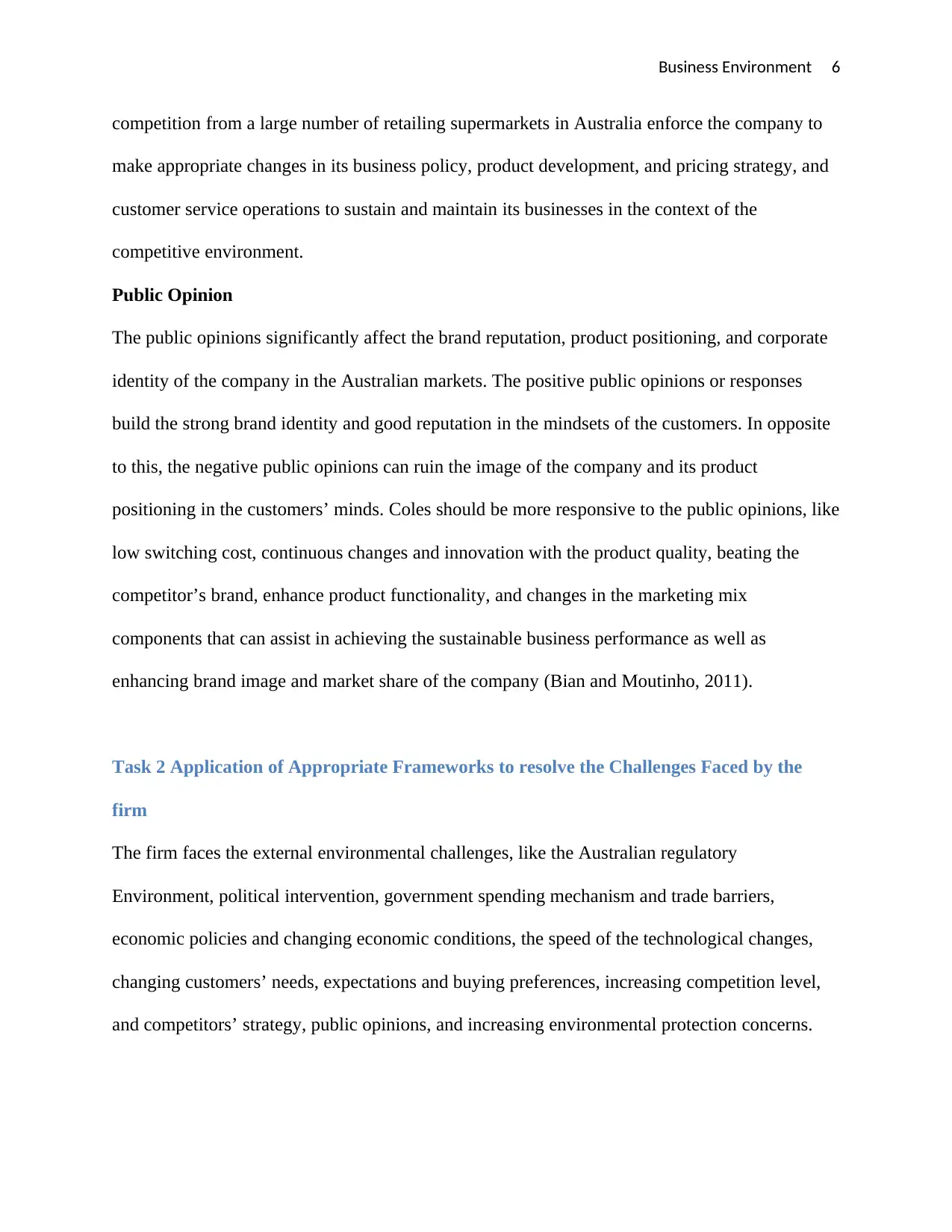
Business Environment 6
competition from a large number of retailing supermarkets in Australia enforce the company to
make appropriate changes in its business policy, product development, and pricing strategy, and
customer service operations to sustain and maintain its businesses in the context of the
competitive environment.
Public Opinion
The public opinions significantly affect the brand reputation, product positioning, and corporate
identity of the company in the Australian markets. The positive public opinions or responses
build the strong brand identity and good reputation in the mindsets of the customers. In opposite
to this, the negative public opinions can ruin the image of the company and its product
positioning in the customers’ minds. Coles should be more responsive to the public opinions, like
low switching cost, continuous changes and innovation with the product quality, beating the
competitor’s brand, enhance product functionality, and changes in the marketing mix
components that can assist in achieving the sustainable business performance as well as
enhancing brand image and market share of the company (Bian and Moutinho, 2011).
Task 2 Application of Appropriate Frameworks to resolve the Challenges Faced by the
firm
The firm faces the external environmental challenges, like the Australian regulatory
Environment, political intervention, government spending mechanism and trade barriers,
economic policies and changing economic conditions, the speed of the technological changes,
changing customers’ needs, expectations and buying preferences, increasing competition level,
and competitors’ strategy, public opinions, and increasing environmental protection concerns.
competition from a large number of retailing supermarkets in Australia enforce the company to
make appropriate changes in its business policy, product development, and pricing strategy, and
customer service operations to sustain and maintain its businesses in the context of the
competitive environment.
Public Opinion
The public opinions significantly affect the brand reputation, product positioning, and corporate
identity of the company in the Australian markets. The positive public opinions or responses
build the strong brand identity and good reputation in the mindsets of the customers. In opposite
to this, the negative public opinions can ruin the image of the company and its product
positioning in the customers’ minds. Coles should be more responsive to the public opinions, like
low switching cost, continuous changes and innovation with the product quality, beating the
competitor’s brand, enhance product functionality, and changes in the marketing mix
components that can assist in achieving the sustainable business performance as well as
enhancing brand image and market share of the company (Bian and Moutinho, 2011).
Task 2 Application of Appropriate Frameworks to resolve the Challenges Faced by the
firm
The firm faces the external environmental challenges, like the Australian regulatory
Environment, political intervention, government spending mechanism and trade barriers,
economic policies and changing economic conditions, the speed of the technological changes,
changing customers’ needs, expectations and buying preferences, increasing competition level,
and competitors’ strategy, public opinions, and increasing environmental protection concerns.
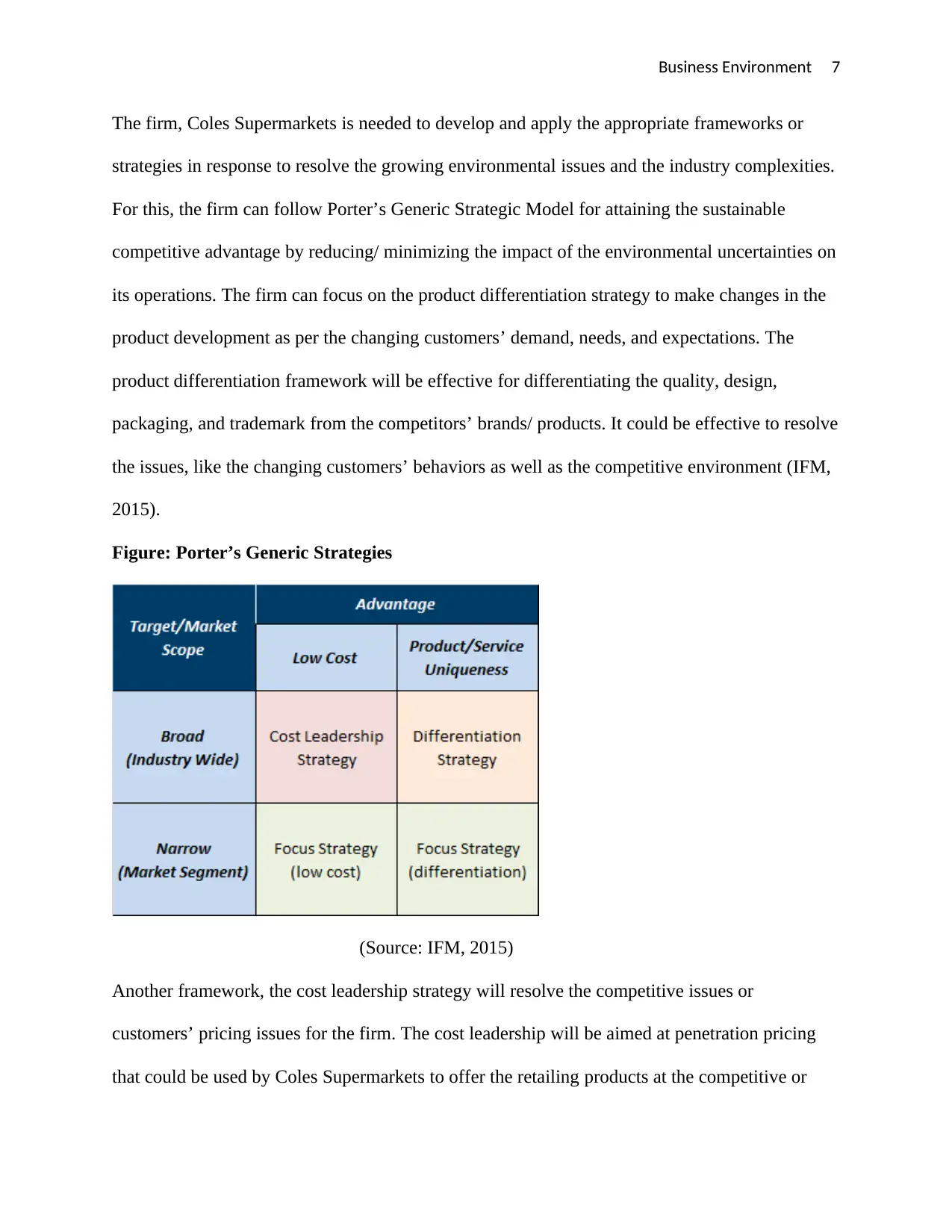
Business Environment 7
The firm, Coles Supermarkets is needed to develop and apply the appropriate frameworks or
strategies in response to resolve the growing environmental issues and the industry complexities.
For this, the firm can follow Porter’s Generic Strategic Model for attaining the sustainable
competitive advantage by reducing/ minimizing the impact of the environmental uncertainties on
its operations. The firm can focus on the product differentiation strategy to make changes in the
product development as per the changing customers’ demand, needs, and expectations. The
product differentiation framework will be effective for differentiating the quality, design,
packaging, and trademark from the competitors’ brands/ products. It could be effective to resolve
the issues, like the changing customers’ behaviors as well as the competitive environment (IFM,
2015).
Figure: Porter’s Generic Strategies
(Source: IFM, 2015)
Another framework, the cost leadership strategy will resolve the competitive issues or
customers’ pricing issues for the firm. The cost leadership will be aimed at penetration pricing
that could be used by Coles Supermarkets to offer the retailing products at the competitive or
The firm, Coles Supermarkets is needed to develop and apply the appropriate frameworks or
strategies in response to resolve the growing environmental issues and the industry complexities.
For this, the firm can follow Porter’s Generic Strategic Model for attaining the sustainable
competitive advantage by reducing/ minimizing the impact of the environmental uncertainties on
its operations. The firm can focus on the product differentiation strategy to make changes in the
product development as per the changing customers’ demand, needs, and expectations. The
product differentiation framework will be effective for differentiating the quality, design,
packaging, and trademark from the competitors’ brands/ products. It could be effective to resolve
the issues, like the changing customers’ behaviors as well as the competitive environment (IFM,
2015).
Figure: Porter’s Generic Strategies
(Source: IFM, 2015)
Another framework, the cost leadership strategy will resolve the competitive issues or
customers’ pricing issues for the firm. The cost leadership will be aimed at penetration pricing
that could be used by Coles Supermarkets to offer the retailing products at the competitive or
Paraphrase This Document
Need a fresh take? Get an instant paraphrase of this document with our AI Paraphraser
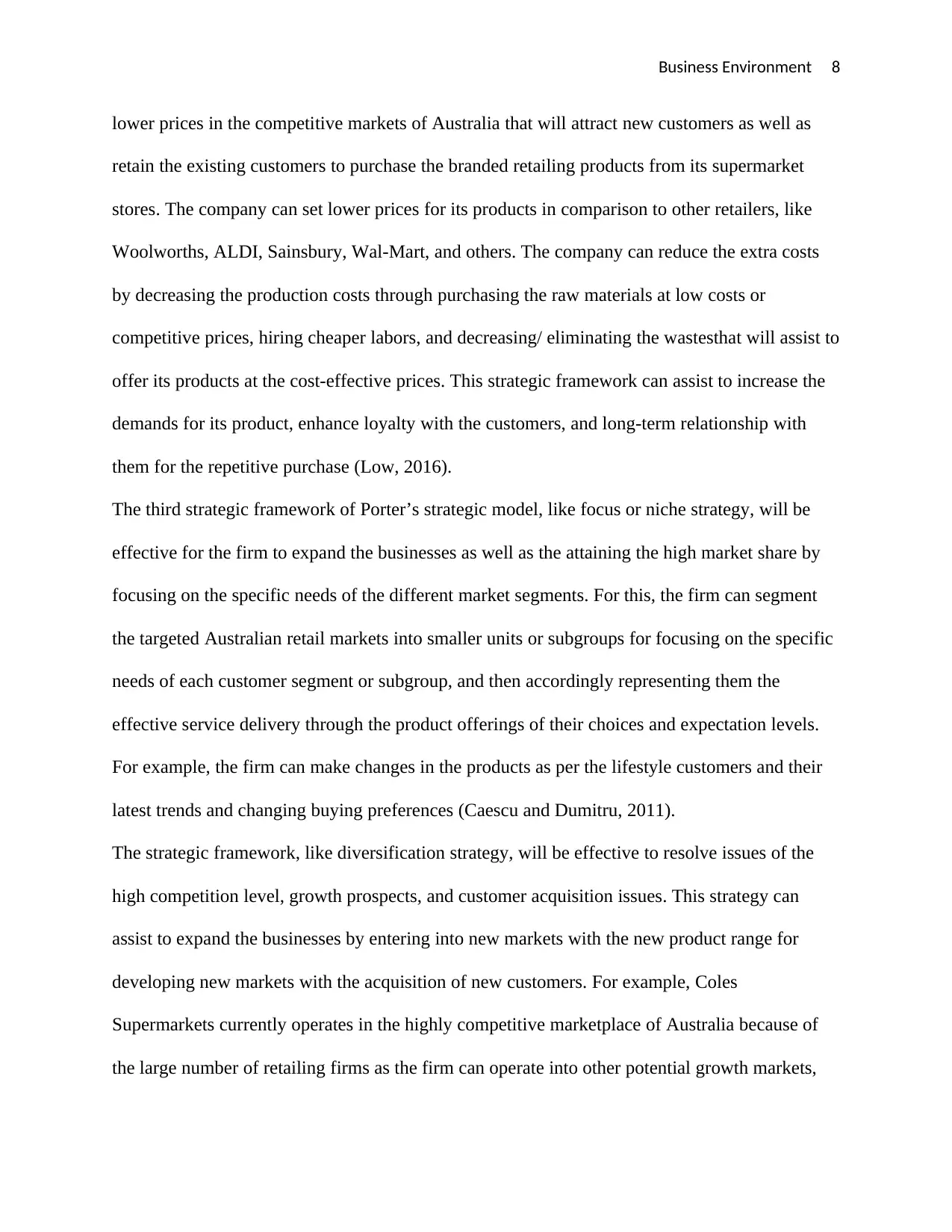
Business Environment 8
lower prices in the competitive markets of Australia that will attract new customers as well as
retain the existing customers to purchase the branded retailing products from its supermarket
stores. The company can set lower prices for its products in comparison to other retailers, like
Woolworths, ALDI, Sainsbury, Wal-Mart, and others. The company can reduce the extra costs
by decreasing the production costs through purchasing the raw materials at low costs or
competitive prices, hiring cheaper labors, and decreasing/ eliminating the wastesthat will assist to
offer its products at the cost-effective prices. This strategic framework can assist to increase the
demands for its product, enhance loyalty with the customers, and long-term relationship with
them for the repetitive purchase (Low, 2016).
The third strategic framework of Porter’s strategic model, like focus or niche strategy, will be
effective for the firm to expand the businesses as well as the attaining the high market share by
focusing on the specific needs of the different market segments. For this, the firm can segment
the targeted Australian retail markets into smaller units or subgroups for focusing on the specific
needs of each customer segment or subgroup, and then accordingly representing them the
effective service delivery through the product offerings of their choices and expectation levels.
For example, the firm can make changes in the products as per the lifestyle customers and their
latest trends and changing buying preferences (Caescu and Dumitru, 2011).
The strategic framework, like diversification strategy, will be effective to resolve issues of the
high competition level, growth prospects, and customer acquisition issues. This strategy can
assist to expand the businesses by entering into new markets with the new product range for
developing new markets with the acquisition of new customers. For example, Coles
Supermarkets currently operates in the highly competitive marketplace of Australia because of
the large number of retailing firms as the firm can operate into other potential growth markets,
lower prices in the competitive markets of Australia that will attract new customers as well as
retain the existing customers to purchase the branded retailing products from its supermarket
stores. The company can set lower prices for its products in comparison to other retailers, like
Woolworths, ALDI, Sainsbury, Wal-Mart, and others. The company can reduce the extra costs
by decreasing the production costs through purchasing the raw materials at low costs or
competitive prices, hiring cheaper labors, and decreasing/ eliminating the wastesthat will assist to
offer its products at the cost-effective prices. This strategic framework can assist to increase the
demands for its product, enhance loyalty with the customers, and long-term relationship with
them for the repetitive purchase (Low, 2016).
The third strategic framework of Porter’s strategic model, like focus or niche strategy, will be
effective for the firm to expand the businesses as well as the attaining the high market share by
focusing on the specific needs of the different market segments. For this, the firm can segment
the targeted Australian retail markets into smaller units or subgroups for focusing on the specific
needs of each customer segment or subgroup, and then accordingly representing them the
effective service delivery through the product offerings of their choices and expectation levels.
For example, the firm can make changes in the products as per the lifestyle customers and their
latest trends and changing buying preferences (Caescu and Dumitru, 2011).
The strategic framework, like diversification strategy, will be effective to resolve issues of the
high competition level, growth prospects, and customer acquisition issues. This strategy can
assist to expand the businesses by entering into new markets with the new product range for
developing new markets with the acquisition of new customers. For example, Coles
Supermarkets currently operates in the highly competitive marketplace of Australia because of
the large number of retailing firms as the firm can operate into other potential growth markets,
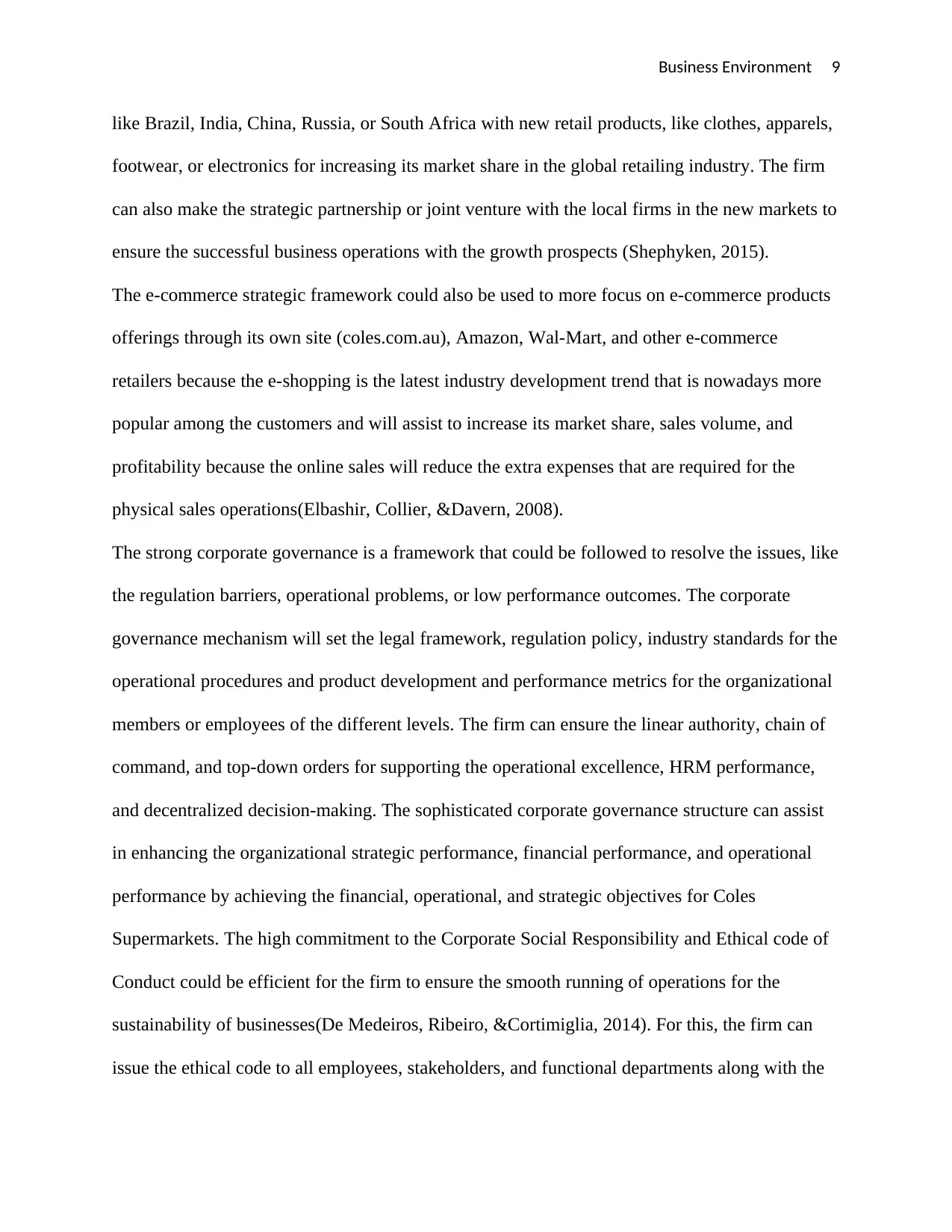
Business Environment 9
like Brazil, India, China, Russia, or South Africa with new retail products, like clothes, apparels,
footwear, or electronics for increasing its market share in the global retailing industry. The firm
can also make the strategic partnership or joint venture with the local firms in the new markets to
ensure the successful business operations with the growth prospects (Shephyken, 2015).
The e-commerce strategic framework could also be used to more focus on e-commerce products
offerings through its own site (coles.com.au), Amazon, Wal-Mart, and other e-commerce
retailers because the e-shopping is the latest industry development trend that is nowadays more
popular among the customers and will assist to increase its market share, sales volume, and
profitability because the online sales will reduce the extra expenses that are required for the
physical sales operations(Elbashir, Collier, &Davern, 2008).
The strong corporate governance is a framework that could be followed to resolve the issues, like
the regulation barriers, operational problems, or low performance outcomes. The corporate
governance mechanism will set the legal framework, regulation policy, industry standards for the
operational procedures and product development and performance metrics for the organizational
members or employees of the different levels. The firm can ensure the linear authority, chain of
command, and top-down orders for supporting the operational excellence, HRM performance,
and decentralized decision-making. The sophisticated corporate governance structure can assist
in enhancing the organizational strategic performance, financial performance, and operational
performance by achieving the financial, operational, and strategic objectives for Coles
Supermarkets. The high commitment to the Corporate Social Responsibility and Ethical code of
Conduct could be efficient for the firm to ensure the smooth running of operations for the
sustainability of businesses(De Medeiros, Ribeiro, &Cortimiglia, 2014). For this, the firm can
issue the ethical code to all employees, stakeholders, and functional departments along with the
like Brazil, India, China, Russia, or South Africa with new retail products, like clothes, apparels,
footwear, or electronics for increasing its market share in the global retailing industry. The firm
can also make the strategic partnership or joint venture with the local firms in the new markets to
ensure the successful business operations with the growth prospects (Shephyken, 2015).
The e-commerce strategic framework could also be used to more focus on e-commerce products
offerings through its own site (coles.com.au), Amazon, Wal-Mart, and other e-commerce
retailers because the e-shopping is the latest industry development trend that is nowadays more
popular among the customers and will assist to increase its market share, sales volume, and
profitability because the online sales will reduce the extra expenses that are required for the
physical sales operations(Elbashir, Collier, &Davern, 2008).
The strong corporate governance is a framework that could be followed to resolve the issues, like
the regulation barriers, operational problems, or low performance outcomes. The corporate
governance mechanism will set the legal framework, regulation policy, industry standards for the
operational procedures and product development and performance metrics for the organizational
members or employees of the different levels. The firm can ensure the linear authority, chain of
command, and top-down orders for supporting the operational excellence, HRM performance,
and decentralized decision-making. The sophisticated corporate governance structure can assist
in enhancing the organizational strategic performance, financial performance, and operational
performance by achieving the financial, operational, and strategic objectives for Coles
Supermarkets. The high commitment to the Corporate Social Responsibility and Ethical code of
Conduct could be efficient for the firm to ensure the smooth running of operations for the
sustainability of businesses(De Medeiros, Ribeiro, &Cortimiglia, 2014). For this, the firm can
issue the ethical code to all employees, stakeholders, and functional departments along with the
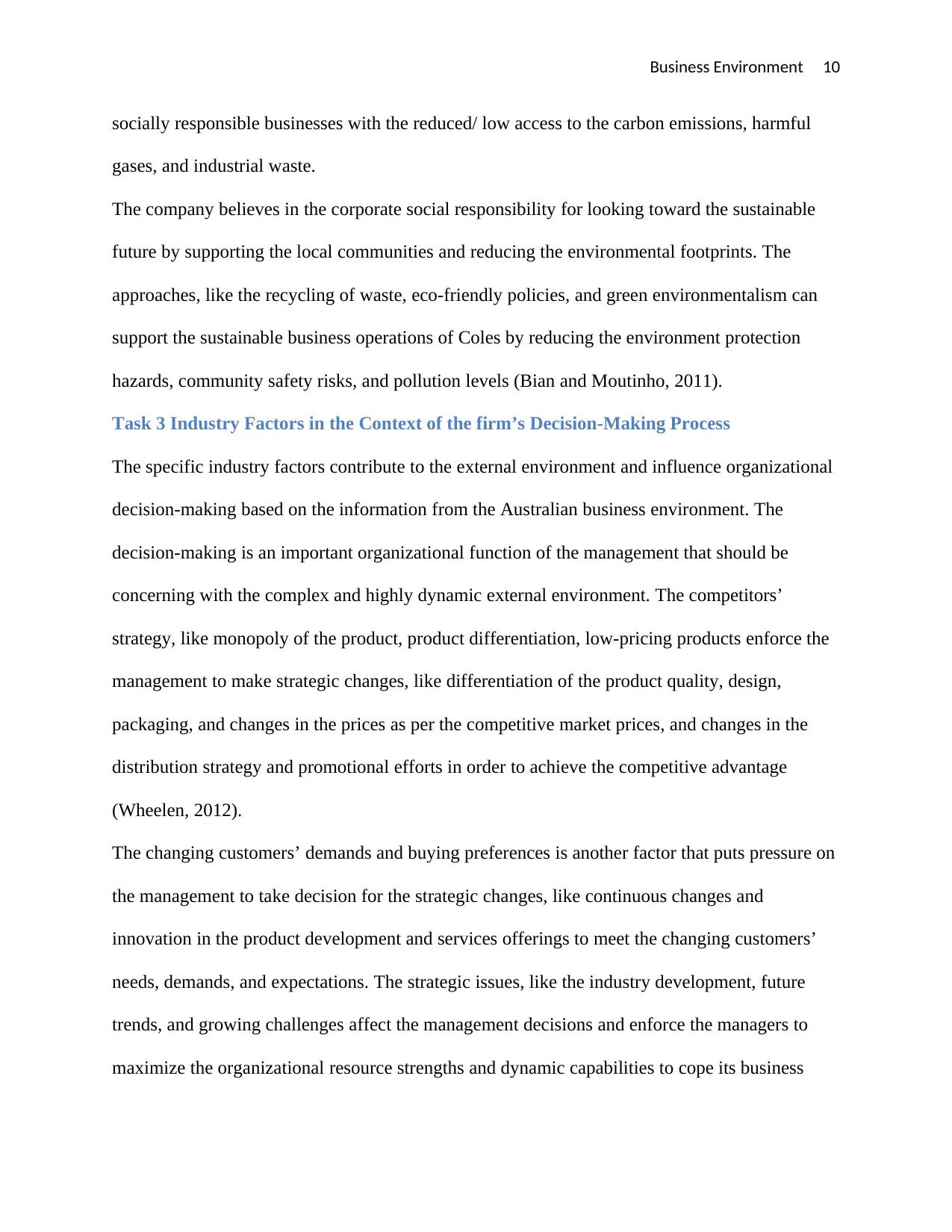
Business Environment 10
socially responsible businesses with the reduced/ low access to the carbon emissions, harmful
gases, and industrial waste.
The company believes in the corporate social responsibility for looking toward the sustainable
future by supporting the local communities and reducing the environmental footprints. The
approaches, like the recycling of waste, eco-friendly policies, and green environmentalism can
support the sustainable business operations of Coles by reducing the environment protection
hazards, community safety risks, and pollution levels (Bian and Moutinho, 2011).
Task 3 Industry Factors in the Context of the firm’s Decision-Making Process
The specific industry factors contribute to the external environment and influence organizational
decision-making based on the information from the Australian business environment. The
decision-making is an important organizational function of the management that should be
concerning with the complex and highly dynamic external environment. The competitors’
strategy, like monopoly of the product, product differentiation, low-pricing products enforce the
management to make strategic changes, like differentiation of the product quality, design,
packaging, and changes in the prices as per the competitive market prices, and changes in the
distribution strategy and promotional efforts in order to achieve the competitive advantage
(Wheelen, 2012).
The changing customers’ demands and buying preferences is another factor that puts pressure on
the management to take decision for the strategic changes, like continuous changes and
innovation in the product development and services offerings to meet the changing customers’
needs, demands, and expectations. The strategic issues, like the industry development, future
trends, and growing challenges affect the management decisions and enforce the managers to
maximize the organizational resource strengths and dynamic capabilities to cope its business
socially responsible businesses with the reduced/ low access to the carbon emissions, harmful
gases, and industrial waste.
The company believes in the corporate social responsibility for looking toward the sustainable
future by supporting the local communities and reducing the environmental footprints. The
approaches, like the recycling of waste, eco-friendly policies, and green environmentalism can
support the sustainable business operations of Coles by reducing the environment protection
hazards, community safety risks, and pollution levels (Bian and Moutinho, 2011).
Task 3 Industry Factors in the Context of the firm’s Decision-Making Process
The specific industry factors contribute to the external environment and influence organizational
decision-making based on the information from the Australian business environment. The
decision-making is an important organizational function of the management that should be
concerning with the complex and highly dynamic external environment. The competitors’
strategy, like monopoly of the product, product differentiation, low-pricing products enforce the
management to make strategic changes, like differentiation of the product quality, design,
packaging, and changes in the prices as per the competitive market prices, and changes in the
distribution strategy and promotional efforts in order to achieve the competitive advantage
(Wheelen, 2012).
The changing customers’ demands and buying preferences is another factor that puts pressure on
the management to take decision for the strategic changes, like continuous changes and
innovation in the product development and services offerings to meet the changing customers’
needs, demands, and expectations. The strategic issues, like the industry development, future
trends, and growing challenges affect the management decisions and enforce the managers to
maximize the organizational resource strengths and dynamic capabilities to cope its business
Secure Best Marks with AI Grader
Need help grading? Try our AI Grader for instant feedback on your assignments.
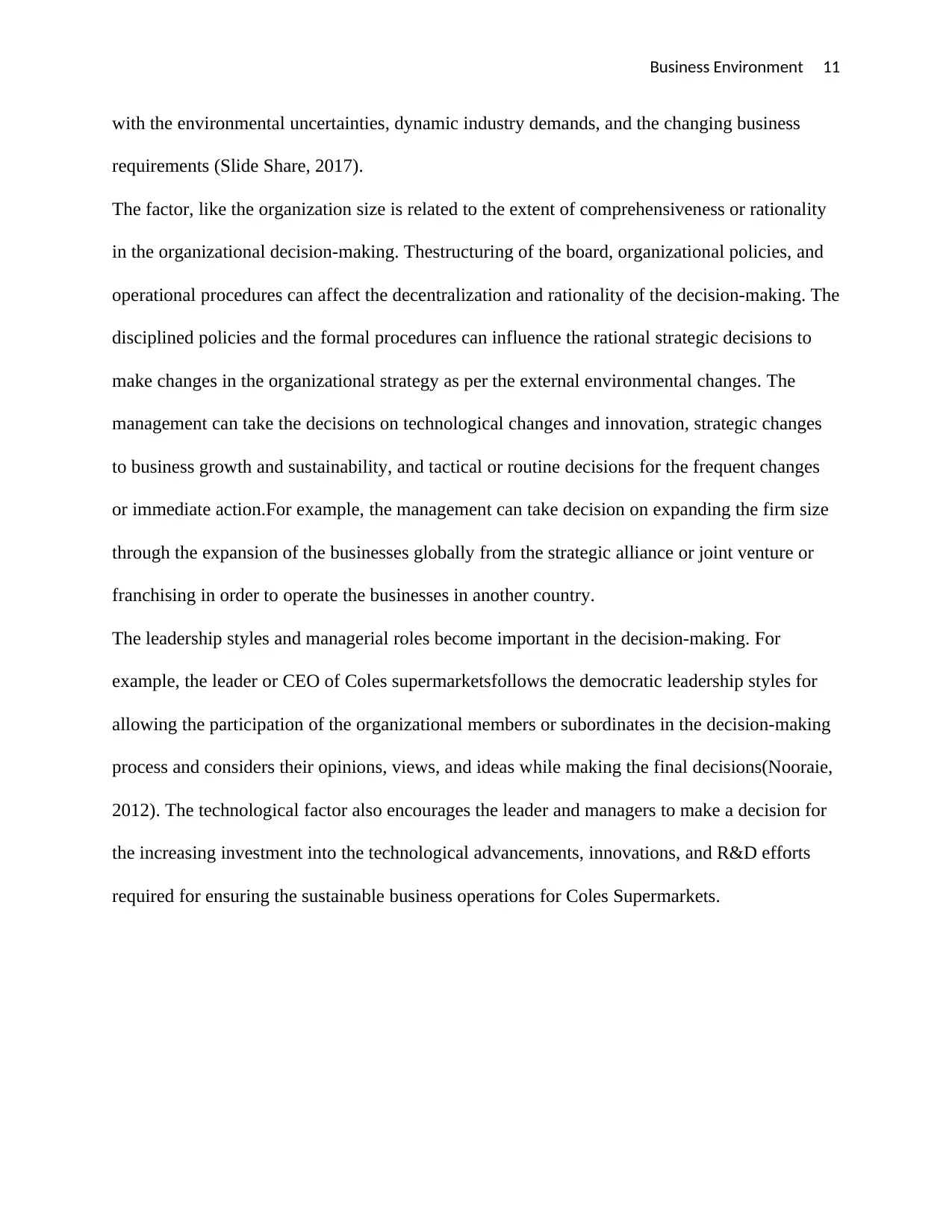
Business Environment 11
with the environmental uncertainties, dynamic industry demands, and the changing business
requirements (Slide Share, 2017).
The factor, like the organization size is related to the extent of comprehensiveness or rationality
in the organizational decision-making. Thestructuring of the board, organizational policies, and
operational procedures can affect the decentralization and rationality of the decision-making. The
disciplined policies and the formal procedures can influence the rational strategic decisions to
make changes in the organizational strategy as per the external environmental changes. The
management can take the decisions on technological changes and innovation, strategic changes
to business growth and sustainability, and tactical or routine decisions for the frequent changes
or immediate action.For example, the management can take decision on expanding the firm size
through the expansion of the businesses globally from the strategic alliance or joint venture or
franchising in order to operate the businesses in another country.
The leadership styles and managerial roles become important in the decision-making. For
example, the leader or CEO of Coles supermarketsfollows the democratic leadership styles for
allowing the participation of the organizational members or subordinates in the decision-making
process and considers their opinions, views, and ideas while making the final decisions(Nooraie,
2012). The technological factor also encourages the leader and managers to make a decision for
the increasing investment into the technological advancements, innovations, and R&D efforts
required for ensuring the sustainable business operations for Coles Supermarkets.
with the environmental uncertainties, dynamic industry demands, and the changing business
requirements (Slide Share, 2017).
The factor, like the organization size is related to the extent of comprehensiveness or rationality
in the organizational decision-making. Thestructuring of the board, organizational policies, and
operational procedures can affect the decentralization and rationality of the decision-making. The
disciplined policies and the formal procedures can influence the rational strategic decisions to
make changes in the organizational strategy as per the external environmental changes. The
management can take the decisions on technological changes and innovation, strategic changes
to business growth and sustainability, and tactical or routine decisions for the frequent changes
or immediate action.For example, the management can take decision on expanding the firm size
through the expansion of the businesses globally from the strategic alliance or joint venture or
franchising in order to operate the businesses in another country.
The leadership styles and managerial roles become important in the decision-making. For
example, the leader or CEO of Coles supermarketsfollows the democratic leadership styles for
allowing the participation of the organizational members or subordinates in the decision-making
process and considers their opinions, views, and ideas while making the final decisions(Nooraie,
2012). The technological factor also encourages the leader and managers to make a decision for
the increasing investment into the technological advancements, innovations, and R&D efforts
required for ensuring the sustainable business operations for Coles Supermarkets.
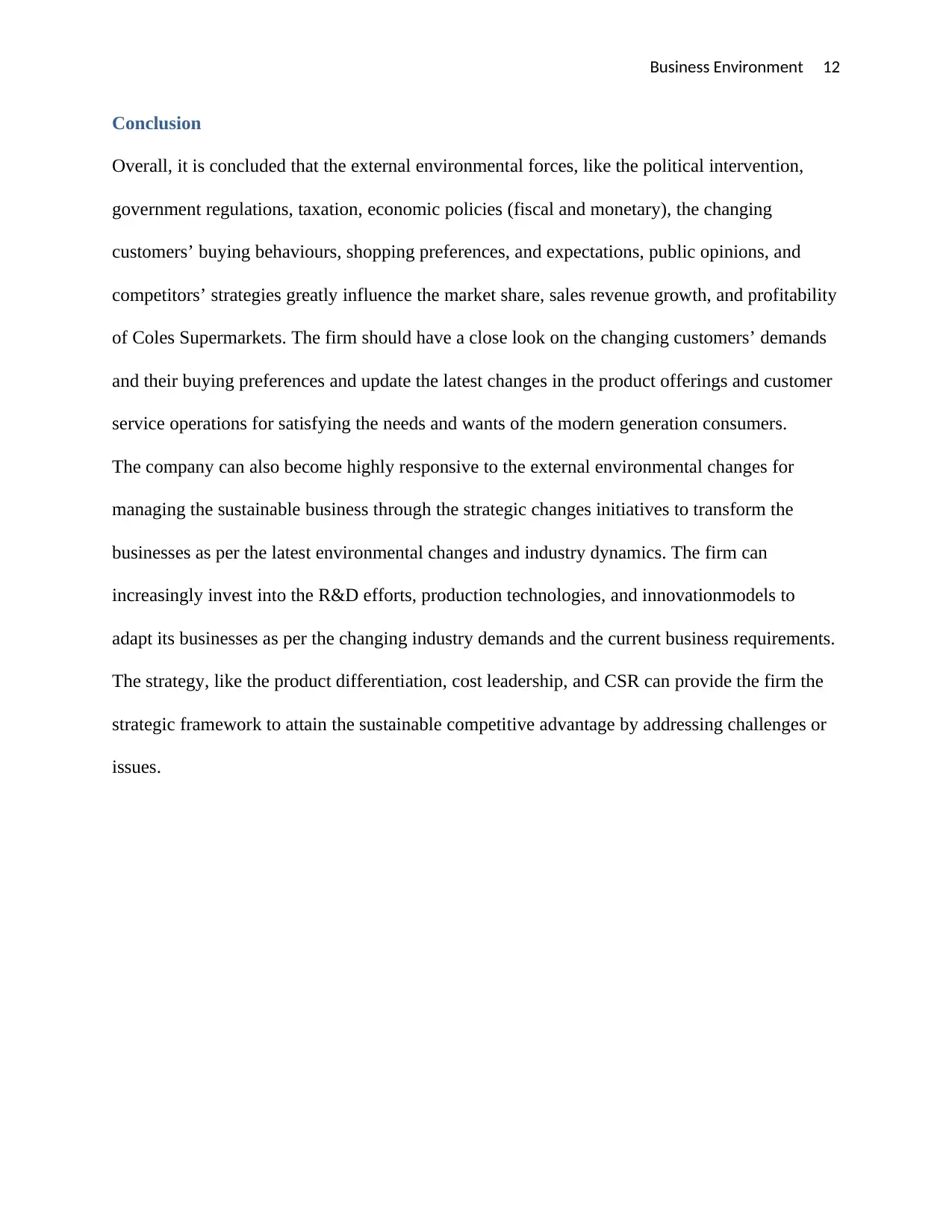
Business Environment 12
Conclusion
Overall, it is concluded that the external environmental forces, like the political intervention,
government regulations, taxation, economic policies (fiscal and monetary), the changing
customers’ buying behaviours, shopping preferences, and expectations, public opinions, and
competitors’ strategies greatly influence the market share, sales revenue growth, and profitability
of Coles Supermarkets. The firm should have a close look on the changing customers’ demands
and their buying preferences and update the latest changes in the product offerings and customer
service operations for satisfying the needs and wants of the modern generation consumers.
The company can also become highly responsive to the external environmental changes for
managing the sustainable business through the strategic changes initiatives to transform the
businesses as per the latest environmental changes and industry dynamics. The firm can
increasingly invest into the R&D efforts, production technologies, and innovationmodels to
adapt its businesses as per the changing industry demands and the current business requirements.
The strategy, like the product differentiation, cost leadership, and CSR can provide the firm the
strategic framework to attain the sustainable competitive advantage by addressing challenges or
issues.
Conclusion
Overall, it is concluded that the external environmental forces, like the political intervention,
government regulations, taxation, economic policies (fiscal and monetary), the changing
customers’ buying behaviours, shopping preferences, and expectations, public opinions, and
competitors’ strategies greatly influence the market share, sales revenue growth, and profitability
of Coles Supermarkets. The firm should have a close look on the changing customers’ demands
and their buying preferences and update the latest changes in the product offerings and customer
service operations for satisfying the needs and wants of the modern generation consumers.
The company can also become highly responsive to the external environmental changes for
managing the sustainable business through the strategic changes initiatives to transform the
businesses as per the latest environmental changes and industry dynamics. The firm can
increasingly invest into the R&D efforts, production technologies, and innovationmodels to
adapt its businesses as per the changing industry demands and the current business requirements.
The strategy, like the product differentiation, cost leadership, and CSR can provide the firm the
strategic framework to attain the sustainable competitive advantage by addressing challenges or
issues.
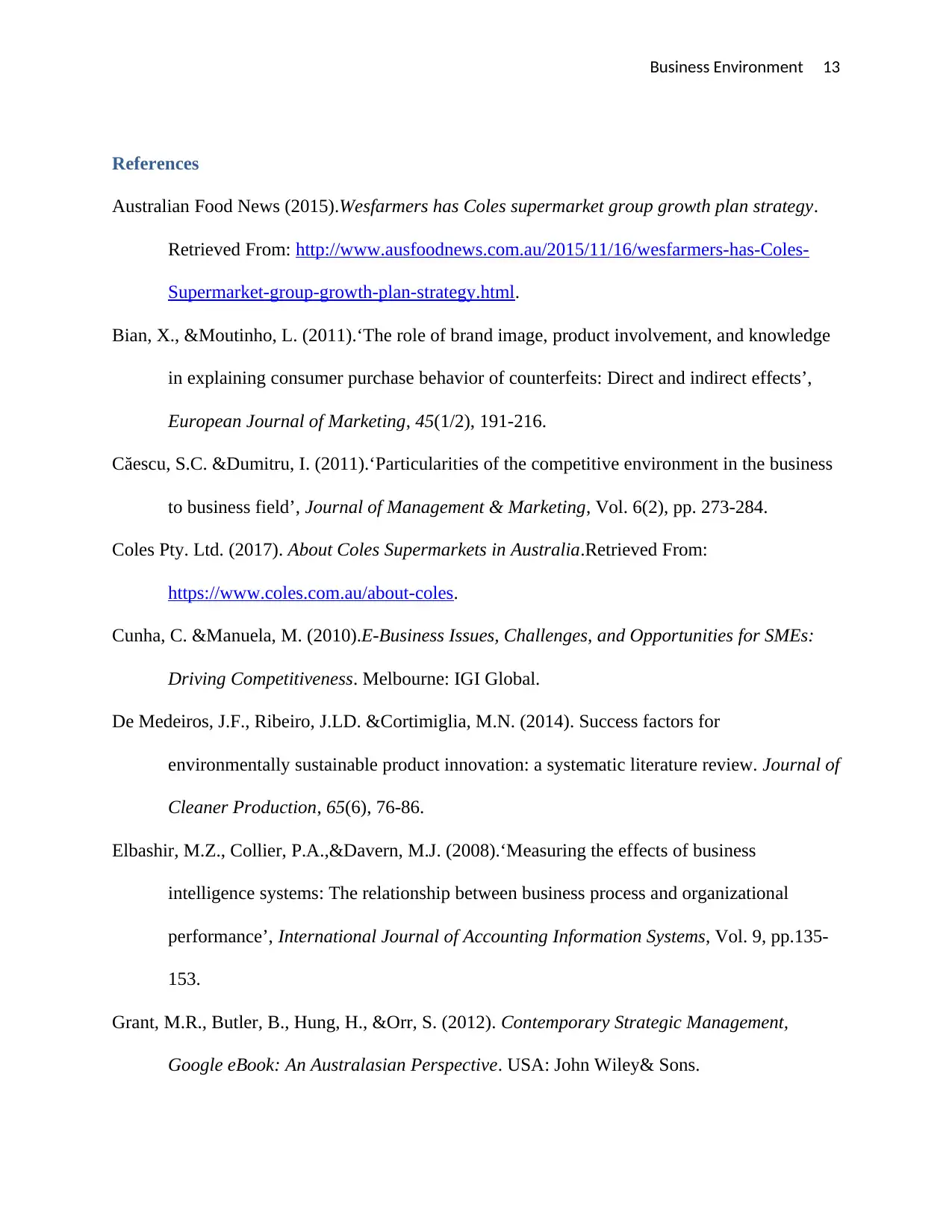
Business Environment 13
References
Australian Food News (2015).Wesfarmers has Coles supermarket group growth plan strategy.
Retrieved From: http://www.ausfoodnews.com.au/2015/11/16/wesfarmers-has-Coles-
Supermarket-group-growth-plan-strategy.html.
Bian, X., &Moutinho, L. (2011).‘The role of brand image, product involvement, and knowledge
in explaining consumer purchase behavior of counterfeits: Direct and indirect effects’,
European Journal of Marketing, 45(1/2), 191-216.
Căescu, S.C. &Dumitru, I. (2011).‘Particularities of the competitive environment in the business
to business field’, Journal of Management & Marketing, Vol. 6(2), pp. 273-284.
Coles Pty. Ltd. (2017). About Coles Supermarkets in Australia.Retrieved From:
https://www.coles.com.au/about-coles.
Cunha, C. &Manuela, M. (2010).E-Business Issues, Challenges, and Opportunities for SMEs:
Driving Competitiveness. Melbourne: IGI Global.
De Medeiros, J.F., Ribeiro, J.LD. &Cortimiglia, M.N. (2014). Success factors for
environmentally sustainable product innovation: a systematic literature review. Journal of
Cleaner Production, 65(6), 76-86.
Elbashir, M.Z., Collier, P.A.,&Davern, M.J. (2008).‘Measuring the effects of business
intelligence systems: The relationship between business process and organizational
performance’, International Journal of Accounting Information Systems, Vol. 9, pp.135-
153.
Grant, M.R., Butler, B., Hung, H., &Orr, S. (2012). Contemporary Strategic Management,
Google eBook: An Australasian Perspective. USA: John Wiley& Sons.
References
Australian Food News (2015).Wesfarmers has Coles supermarket group growth plan strategy.
Retrieved From: http://www.ausfoodnews.com.au/2015/11/16/wesfarmers-has-Coles-
Supermarket-group-growth-plan-strategy.html.
Bian, X., &Moutinho, L. (2011).‘The role of brand image, product involvement, and knowledge
in explaining consumer purchase behavior of counterfeits: Direct and indirect effects’,
European Journal of Marketing, 45(1/2), 191-216.
Căescu, S.C. &Dumitru, I. (2011).‘Particularities of the competitive environment in the business
to business field’, Journal of Management & Marketing, Vol. 6(2), pp. 273-284.
Coles Pty. Ltd. (2017). About Coles Supermarkets in Australia.Retrieved From:
https://www.coles.com.au/about-coles.
Cunha, C. &Manuela, M. (2010).E-Business Issues, Challenges, and Opportunities for SMEs:
Driving Competitiveness. Melbourne: IGI Global.
De Medeiros, J.F., Ribeiro, J.LD. &Cortimiglia, M.N. (2014). Success factors for
environmentally sustainable product innovation: a systematic literature review. Journal of
Cleaner Production, 65(6), 76-86.
Elbashir, M.Z., Collier, P.A.,&Davern, M.J. (2008).‘Measuring the effects of business
intelligence systems: The relationship between business process and organizational
performance’, International Journal of Accounting Information Systems, Vol. 9, pp.135-
153.
Grant, M.R., Butler, B., Hung, H., &Orr, S. (2012). Contemporary Strategic Management,
Google eBook: An Australasian Perspective. USA: John Wiley& Sons.
Paraphrase This Document
Need a fresh take? Get an instant paraphrase of this document with our AI Paraphraser
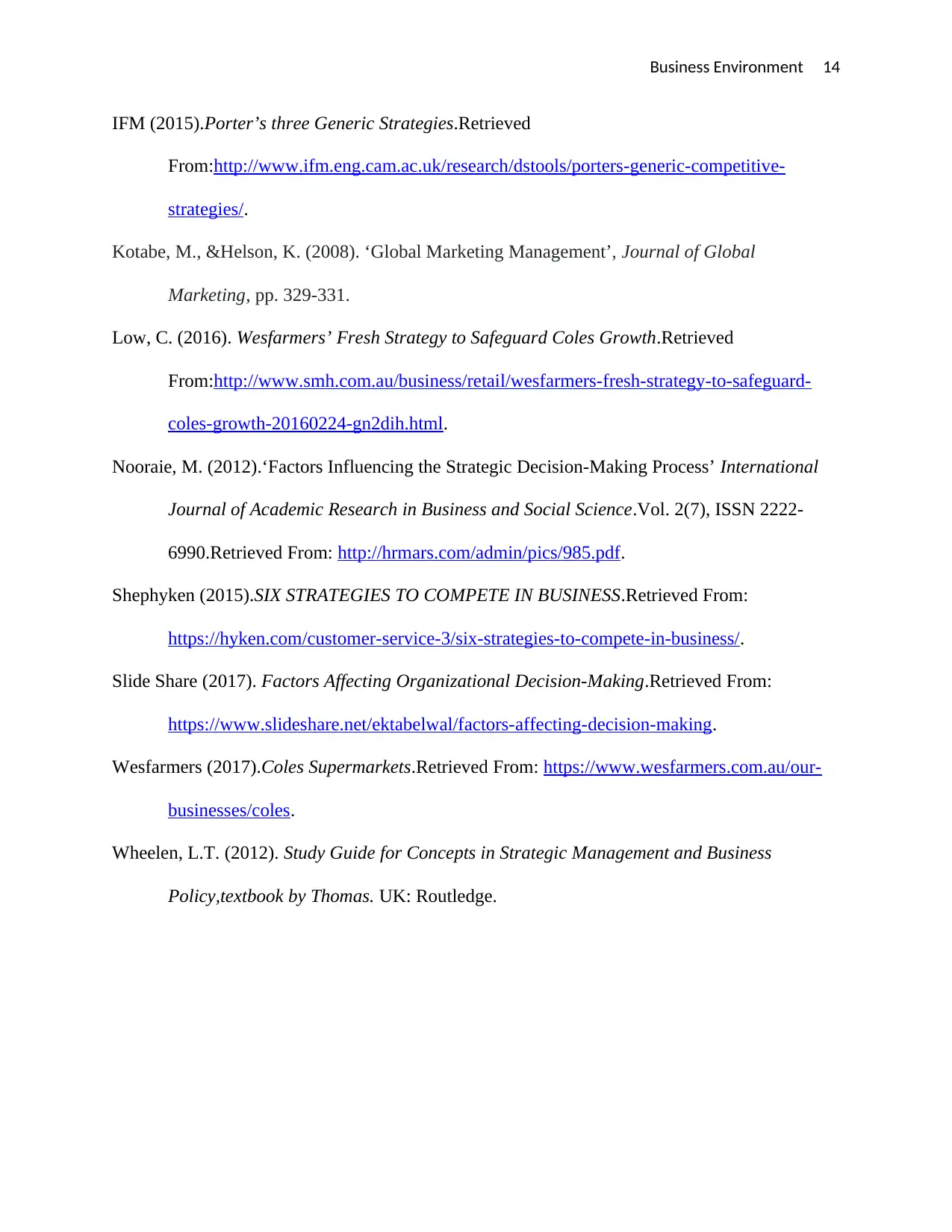
Business Environment 14
IFM (2015).Porter’s three Generic Strategies.Retrieved
From:http://www.ifm.eng.cam.ac.uk/research/dstools/porters-generic-competitive-
strategies/.
Kotabe, M., &Helson, K. (2008). ‘Global Marketing Management’, Journal of Global
Marketing, pp. 329-331.
Low, C. (2016). Wesfarmers’ Fresh Strategy to Safeguard Coles Growth.Retrieved
From:http://www.smh.com.au/business/retail/wesfarmers-fresh-strategy-to-safeguard-
coles-growth-20160224-gn2dih.html.
Nooraie, M. (2012).‘Factors Influencing the Strategic Decision-Making Process’ International
Journal of Academic Research in Business and Social Science.Vol. 2(7), ISSN 2222-
6990.Retrieved From: http://hrmars.com/admin/pics/985.pdf.
Shephyken (2015).SIX STRATEGIES TO COMPETE IN BUSINESS.Retrieved From:
https://hyken.com/customer-service-3/six-strategies-to-compete-in-business/.
Slide Share (2017). Factors Affecting Organizational Decision-Making.Retrieved From:
https://www.slideshare.net/ektabelwal/factors-affecting-decision-making.
Wesfarmers (2017).Coles Supermarkets.Retrieved From: https://www.wesfarmers.com.au/our-
businesses/coles.
Wheelen, L.T. (2012). Study Guide for Concepts in Strategic Management and Business
Policy,textbook by Thomas. UK: Routledge.
IFM (2015).Porter’s three Generic Strategies.Retrieved
From:http://www.ifm.eng.cam.ac.uk/research/dstools/porters-generic-competitive-
strategies/.
Kotabe, M., &Helson, K. (2008). ‘Global Marketing Management’, Journal of Global
Marketing, pp. 329-331.
Low, C. (2016). Wesfarmers’ Fresh Strategy to Safeguard Coles Growth.Retrieved
From:http://www.smh.com.au/business/retail/wesfarmers-fresh-strategy-to-safeguard-
coles-growth-20160224-gn2dih.html.
Nooraie, M. (2012).‘Factors Influencing the Strategic Decision-Making Process’ International
Journal of Academic Research in Business and Social Science.Vol. 2(7), ISSN 2222-
6990.Retrieved From: http://hrmars.com/admin/pics/985.pdf.
Shephyken (2015).SIX STRATEGIES TO COMPETE IN BUSINESS.Retrieved From:
https://hyken.com/customer-service-3/six-strategies-to-compete-in-business/.
Slide Share (2017). Factors Affecting Organizational Decision-Making.Retrieved From:
https://www.slideshare.net/ektabelwal/factors-affecting-decision-making.
Wesfarmers (2017).Coles Supermarkets.Retrieved From: https://www.wesfarmers.com.au/our-
businesses/coles.
Wheelen, L.T. (2012). Study Guide for Concepts in Strategic Management and Business
Policy,textbook by Thomas. UK: Routledge.
1 out of 14
Related Documents
Your All-in-One AI-Powered Toolkit for Academic Success.
+13062052269
info@desklib.com
Available 24*7 on WhatsApp / Email
![[object Object]](/_next/static/media/star-bottom.7253800d.svg)
Unlock your academic potential
© 2024 | Zucol Services PVT LTD | All rights reserved.





